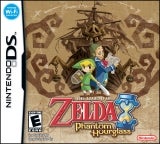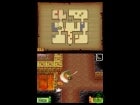The Ocean King's Home is His Castle
What makes the game so satisfying is a great understanding of Zelda design, as well as careful, conservative implementation of the stylus controls. "Solving" each dungeon is a floor-by-floor affair, with puzzles rarely reaching past one level. Despite that, each dungeon is built wonderfully, full of those moments where you shift from "I can't solve this" to an ecstatic "eureka!" They're micro-servings, not the multi-leveled puzzles of a console Zelda, but this isn't a console Zelda.

Combat becomes routine fairly quickly, but this is Zelda, not Ninja Gaiden; series veterans should have already been planning on avoiding most monsters. Newcomers should enjoy getting to play a "hardcore" game and actually succeed rather than constantly die as they try to figure out what the X button does before quitting to train their brain some more. And where cutting down crows quickly becomes less interesting than avoiding them, boss fights are absolute pleasures.
Boss fights, both on sea and on land, are where the design decisions of Phantom Hourglass shine most satisfyingly. By hardcore standards, the fights are easy; expect to routinely beat bosses on your first try. But boss fights take spectacular advantage of the DS hardware, whether because they have you throwing bombs up at a flying boss to bring him down from the top screen or playing impromptu baseball to bat shots back at a quartet of witches. Visuals and sound compliment some of the best, most enjoyable boss fights in the series.
The top screen is usually your map, but you can easily swap it down to the bottom screen to take notes on. It sounds like a minor feature, but having all of your notes with you, all the time, is a huge perk. It makes taking notes far less frustrating, which means you're more likely to, which makes the whole game less frustrating and more fun. More impressively, once you've used the boomerang or bow with the stylus, you'll never want to go back to those primitive d-pad and face button controls.
Tapping the "use" icon in the upper right hand corner of the touch screen (or holding the left shoulder button) sets you to item mode. Tracing your boomerang's route gives you incredible control over it, making it an integral part of puzzles that wouldn't be nearly as satisfying with any other, less accurate type of control. Barring hitting an obstacle, it will go exactly where you draw. Firing your bow is equally easy and equally superior to standard controls. The game's action controls are a bit too loose to start a stylus-only control revolution, but map notes and item use hit that nail on the head.





